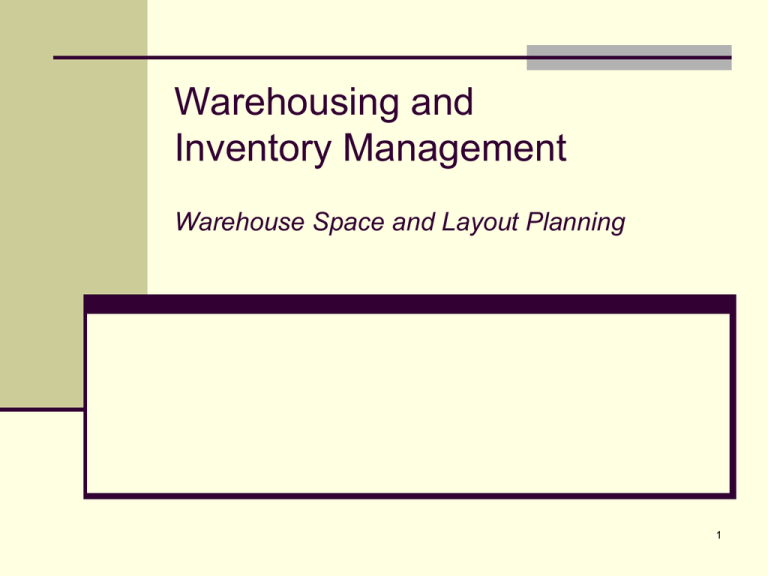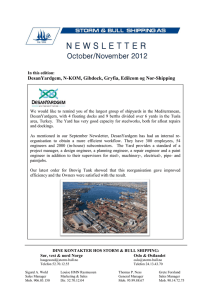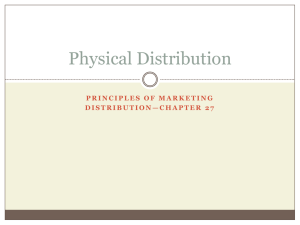2. Warehouse Space a..
advertisement

Warehousing and Inventory Management Warehouse Space and Layout Planning 1 Basic Warehousing Decisions 1. Ownership (rent, lease or build) 2. Size and number of warehouse 3. Where should warehouses be located? 4. How much capacity is required? 5. What type of warehousing layout is appropriate? 2 Warehouse Space Planning What is the one thing you always run out of in a warehouse? The answer is space.................... 3 Warehouse Space Planning 1. Determine what is to be accomplished 2. Determine how to accomplish it 3. Determine space allowances for each element required to accomplish the activity 4. Calculate the total space requirement 4 Two Major Activities Require Space Planning 1. Receiving and Shipping Activities 2. Storage Activities 5 Space Planning for Receiving and Shipping The most important functions of a warehouse take place on the receiving and shipping docks. Unfortunately, these are also the most neglected areas of the warehouse. How then do we plan the space requirements for shipping and receiving? 6 Methodology of Space Planning for Receiving and Shipping 1. Defining the materials received and shipped 2. Determining dock bay requirements 3. Dock bay configuration 4. Manoeuvring allowances inside the warehouse 5. Buffer and Staging area requirements 6. Dock-related space requirements 7 1. Defining the Materials Received and Shipped An excellent tool – Receiving and Shipping Analysis Chart (RSAC) Columns 1-5: define what is to be received or shipped Column 6: size of shipment Column 7: when the receipts and shipments will occur Columns 8-9: list the types of carriers Columns 10-11: handling methods & time required for loading/unloading 8 2. Determine Dock Requirements Determining the requirements for the receiving and shipping dock bays How many dock bays are required? Frequency of activity Carrier inter-arrival time and service time Guessing Waiting-line analysis Simulation How should the dock bays be configured? Types of vehicle at the dock bay 9 3. Basic Dock Configuration 10 Consolidation 11 Consolidation 12 4. Manoeuvring Allowances Inside the Warehouse Space needed to enter and exit the carrier and to travel between the carrier and the receiving buffer area or the shipping staging area Area occupied by the dock leveling devices An aisle located between the back edge of the inside dock leveling device and the receiving buffer area or the shipping staging area Required width: 6-8 feet for manual handling and nonpowered material handling equipment and 8-12 fleet for powered material handling equipment 13 5. Buffer & Staging Area Requirements The receiving buffer area serves as a depository for the materials unloaded from the carrier perform thorough check-in and inspection The shipping staging area serves as an accumulation point for the merchandise that comprise a shipment perform packaging, unitizing or verifying the customer order Determining the amount of the buffer/staging area a matter of the degree of control over the dock area based on how much area is required during the surge periods Existing facilities – by analyzing historical shipping patterns New facilities – ask the anticipated suppliers and users & based on the anticipated surges in activity Aisle space within the buffer/staging area 14 Receiving and Shipping Area 15 6. Determine Dock-Related Space Requirements Office Space Receiving hold area Trash disposal Empty pallet storage Truckers’ lounge 16 Space Planning for Storage Activities 1. Defining materials to be stored 2. Choosing a storage philosophy 3. Space requirements for alternative storage methods 17 1. Defining the Materials to be Stored A useful tool – Storage Analysis Chart (SAC) Columns 1-5: define what material are to be stored Columns 6-8: how much is to be stored Columns 9-12 how the materials are to be stored 18 2. Determine Storage Philosophy 1. Fixed location storage each individual SKU is always stored in a specific location, and no other SKU may be stored in that location, even though that location may be empty 2. Random location storage any SKU may be assigned to any available storage location 19 3. Determine Alternative Storage Method Space Requirements 1.The space requirements are directly related to the volume of material to be stored, and 2. The use-of-space characteristics of the alternative Aisle allowance Honeycombing allowance 20 Aisle & Honeycombing Allowance 1. Aisle allowance is the % of space occupied by aisles It is necessary within a storage area to allow accessibility to the material being stored The amount of aisle allowance depends on the storage method, which dictates the no. of aisles required, and the material handling method, which dictates the size of aisles 2. Honeycombing allowance is the % of storage space lost It occurs whenever a storage location is only partially filled with material and may occur horizontally and vertically The unoccupied area within the storage location is honeycombing space 21 Honeycombing Space 22 Objectives of a Warehouse Layout 1. To use space efficiently 2. To allow the most efficient material handling 3. To provide the most economical storage in relation to costs of equipment, use of space, damage tomaterial and handling labour 4. To provide maximum flexibility in order to meet changing storage and handling requirements 5. To make the warehouse a model of good housekeeping 23 Layout Planning Methodology Layout planning methodology consists of two steps: Generate a series of warehouse layout alternatives Evaluate each alternative against specific criteria to identify the best warehouse layout 24 Generate Alternative Layouts 25 Evaluate the Alternative Layouts 1. Popularity Philosophy 2. Similarity Philosophy 3. Size Philosophy 4. Product Characteristics Philosophy 5. Space Utilization Philosophy Conservation of space Limitations on use of space Accessibility of material Orderliness 26 New concept in warehousing 27 Virtual warehouse Discussion of the implication of virtual warehouse in MSC 28 Q&A 29








